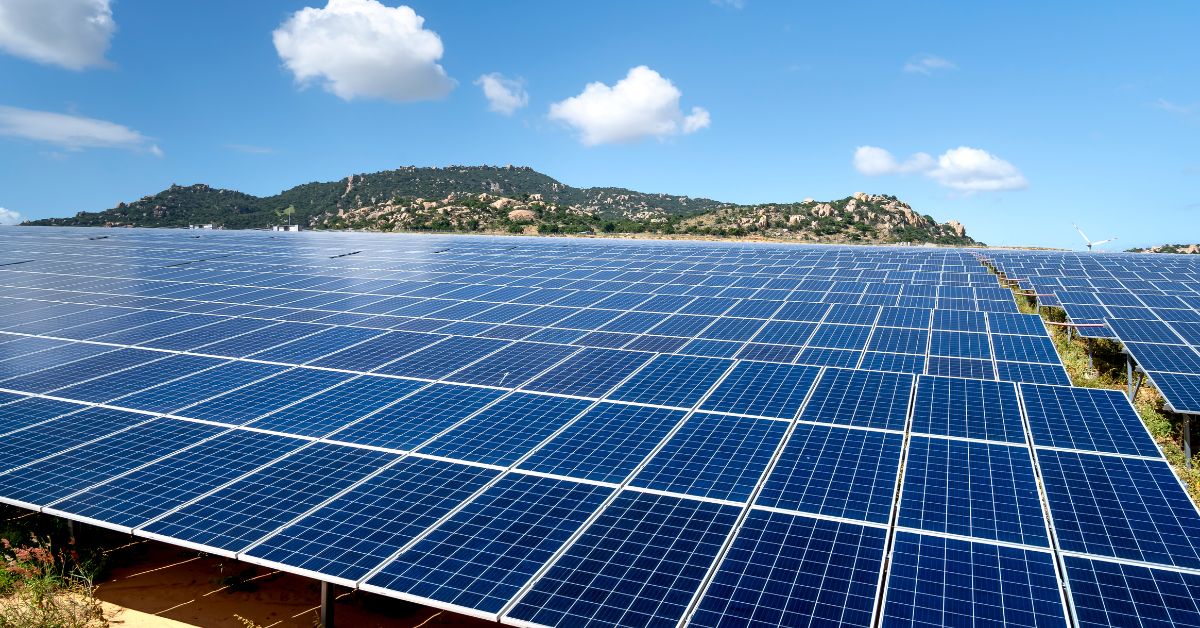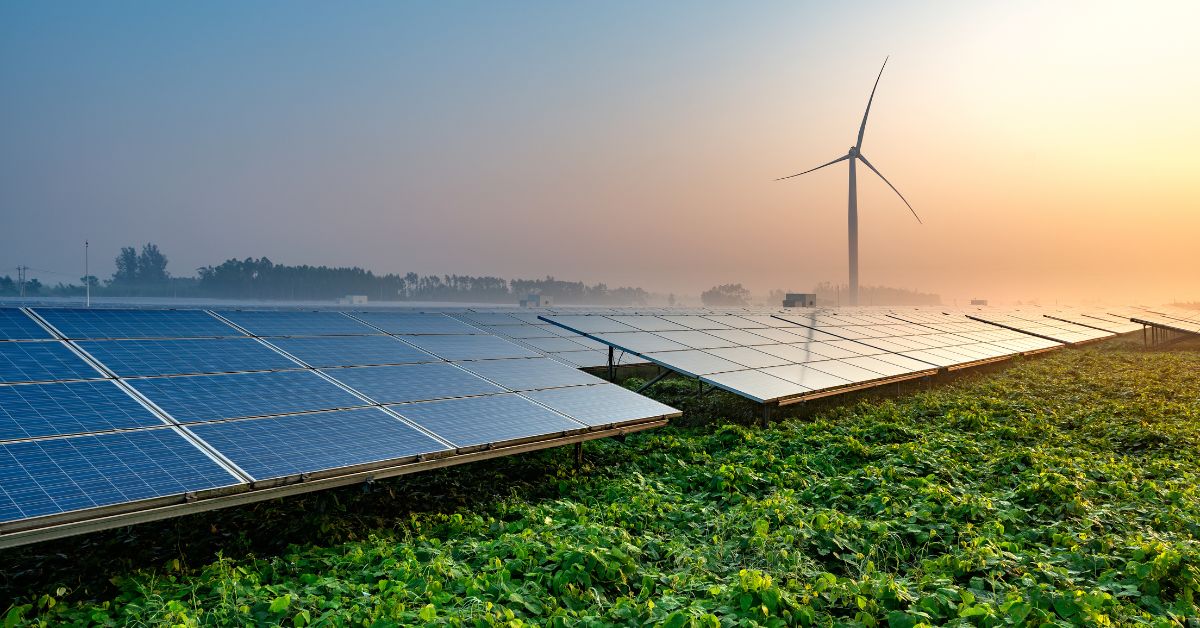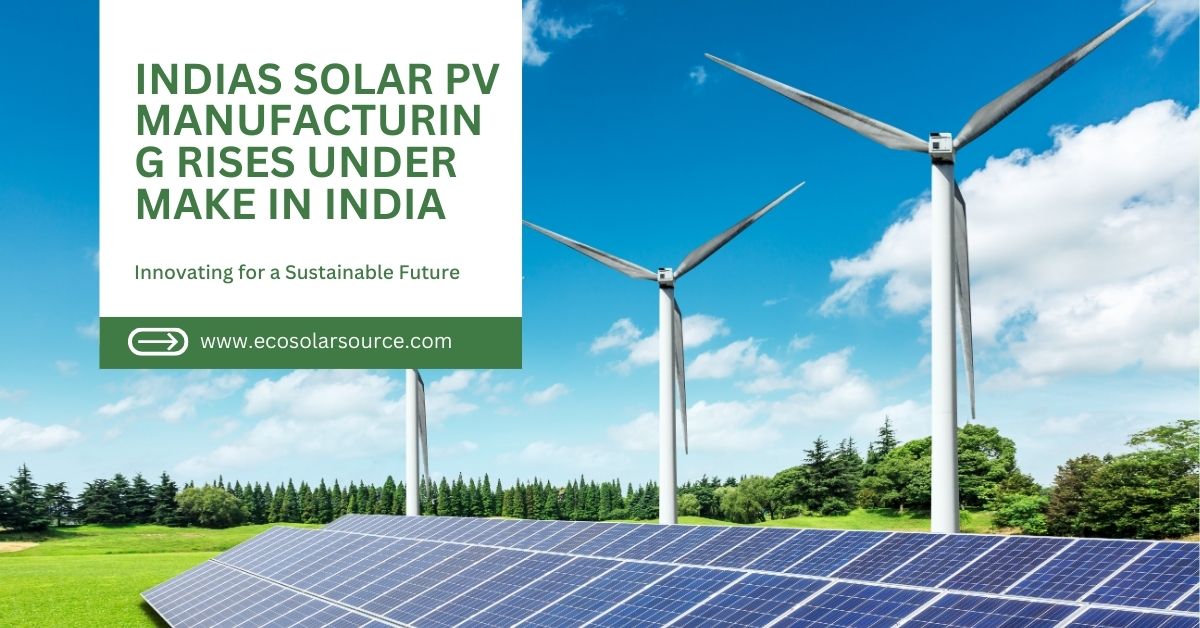Indias Solar PV Manufacturing Rises Under Make in India
Know the details about Indias Solar PV Manufacturing Rises Under Make in India, India’s solar photovoltaic (PV) manufacturing sector is witnessing a significant rise under the “Make in India” initiative. This government-driven campaign aims to boost domestic production and reduce reliance on imported solar modules.
With supportive policies like production-linked incentives (PLI), increased investment, and a focus on self-reliance, India is fast becoming a global hub for solar manufacturing. Major firms are expanding production capacities, while new players enter the market, spurring innovation and employment. This growth aligns with India’s ambitious renewable energy goals, positioning the country as a key player in the global clean energy transition.
Table of Contents
Indias Solar PV Manufacturing Rises Under Make in India
India, the world’s third-largest energy consumer, is undergoing a profound transformation in its energy sector. This shift towards renewable energy, particularly solar power, aligns with the country’s ambitious goals to combat climate change and ensure energy security. Under the government’s flagship initiative, ‘Make in India,’ there has been a significant rise in domestic solar photovoltaic (PV) manufacturing. This article delves into how the ‘Make in India’ initiative is driving growth in India’s solar PV sector, highlighting key developments, challenges, and opportunities for the future.
The Renewable Energy Landscape in India
India’s renewable energy sector has experienced rapid growth over the past decade. As of 2023, the country has more than 120 gigawatts (GW) of installed renewable energy capacity, with solar power accounting for a substantial 66 GW. This surge is driven by the government’s target of achieving 500 GW of renewable energy capacity by 2030, as part of its commitment to the Paris Agreement and the broader agenda for sustainable development.
Solar energy is a critical part of this renewable energy revolution, given India’s geographic advantage of high solar insolation and vast expanses of unused land. However, the majority of solar PV modules used in India’s solar power installations have historically been imported, particularly from China. To reduce reliance on imports, promote self-reliance, and foster local industries, the government launched the ‘Make in India’ initiative in 2014. This initiative aims to make India a global manufacturing hub and build resilience in sectors critical for the nation’s future, including renewable energy.
The Role of ‘Make in India’ in Solar PV Manufacturing
Policy Push and Incentives
‘Make in India’ is not merely a slogan but a broad industrial policy that encourages domestic manufacturing across sectors. In the context of solar PV manufacturing, the government has rolled out several initiatives to attract investment and build capacity in the solar industry.

- Production Linked Incentive (PLI) Scheme: In 2020, the government introduced the PLI scheme specifically for solar PV manufacturing. The scheme, with an initial outlay of ₹4,500 crores (approximately $600 million), aims to boost local production of high-efficiency solar modules. The PLI scheme rewards companies for achieving specific output targets, ensuring that they not only manufacture components but also scale up operations to meet domestic and international demand.
- Domestic Content Requirement (DCR): Under certain government-sponsored solar projects, there is a mandate to use domestically manufactured solar cells and modules. This policy not only supports local manufacturers but also ensures that the quality of solar installations remains high.
- Safeguard Duties and Tariffs: To protect nascent domestic industries from cheap imports, particularly from China, India has implemented safeguard duties on imported solar PV modules. In 2021, the Basic Customs Duty (BCD) on imported solar cells was set at 25%, while that on modules was set at 40%. These duties are intended to create a level playing field for Indian manufacturers.
Infrastructure and Capacity Building
One of the critical areas of focus under the ‘Make in India’ initiative is developing the infrastructure necessary to support large-scale solar PV manufacturing. The country has established several solar parks and Special Economic Zones (SEZs) to provide a conducive environment for solar manufacturers. The government has also invested in research and development (R&D) to improve the efficiency and durability of solar PV technology produced domestically.
Increased Participation from the Private Sector
The ‘Make in India’ initiative has also galvanized participation from private companies in solar manufacturing. Indian conglomerates, such as Reliance Industries and Adani Group, have made significant investments in setting up large-scale solar PV manufacturing facilities. In 2021, Reliance announced plans to invest over ₹75,000 crores ($10 billion) in renewable energy over three years, which includes the establishment of an integrated solar photovoltaic module manufacturing plant.
Adani Solar, another key player, has also ramped up its solar PV manufacturing capacity. By 2022, Adani Solar had a production capacity of 3.5 GW and plans to expand further in the coming years. These private investments, coupled with government support, are critical in scaling India’s domestic manufacturing capacity to meet both local demand and international export opportunities.
Technological Advancements in Indian Solar PV Manufacturing
The solar PV manufacturing sector is highly technology-driven, with advancements being made continuously to improve the efficiency and cost-effectiveness of solar modules. India’s efforts under the ‘Make in India’ initiative are focused on embracing these advancements to ensure the competitiveness of its products in the global market.
Transition to High-Efficiency Modules
Indian manufacturers are increasingly moving towards the production of high-efficiency solar modules, such as bifacial modules and monocrystalline PERC (Passivated Emitter and Rear Cell) technology. These modules offer higher efficiency compared to traditional polycrystalline modules, allowing for more energy generation in a smaller area. This shift is essential for meeting the growing demand for rooftop solar installations in urban areas, where space is limited.
Integrated Manufacturing Facilities
A key trend in the Indian solar PV manufacturing sector is the development of integrated manufacturing facilities. Instead of focusing on a single component (e.g., solar cells), companies are setting up plants that cover the entire value chain—from silicon wafer production to the assembly of finished modules. This approach reduces dependency on imports and enhances the overall competitiveness of Indian products.
For instance, companies like Tata Power Solar have invested in vertically integrated manufacturing units that produce everything from wafers to fully assembled solar modules. These integrated facilities not only reduce costs but also ensure greater control over the quality of the final product.
Innovation in Thin-Film Solar Cells
Another exciting area of innovation is the development of thin-film solar cells, which are lightweight and flexible compared to traditional silicon-based cells. Indian research institutions and companies are investing in R&D to commercialize these technologies, which hold the potential to revolutionize solar applications, particularly in areas such as solar-powered transportation and building-integrated photovoltaics (BIPV).
Challenges Facing Solar PV Manufacturing in India
While the rise of solar PV manufacturing under the ‘Make in India’ initiative is promising, several challenges must be addressed to ensure long-term success and global competitiveness.

Dependence on Imports for Raw Materials
One of the primary challenges facing Indian solar manufacturers is the heavy reliance on imports for critical raw materials such as silicon wafers and polysilicon. These materials are mostly sourced from countries like China, making Indian manufacturers vulnerable to supply chain disruptions and price fluctuations. Developing a domestic supply chain for these raw materials is crucial for reducing costs and increasing the self-reliance of the Indian solar industry.
High Capital Costs
Setting up solar PV manufacturing facilities requires significant capital investment, particularly in the production of high-efficiency modules and cutting-edge technologies like thin-film cells. Although the PLI scheme and other government incentives help, many manufacturers face difficulties in securing the financing needed to scale up production to globally competitive levels. Encouraging more domestic and foreign investment in solar manufacturing is essential to overcoming this hurdle.
Technological Gaps
While Indian manufacturers are making strides in producing advanced solar technologies, there remains a gap between India and global leaders in terms of R&D and innovation. Bridging this gap requires greater investment in research and collaboration with international technology providers. Developing stronger partnerships between Indian universities, research institutions, and the private sector can help accelerate innovation in the solar PV space.
Opportunities for Growth in India’s Solar PV Sector
Despite these challenges, the future of solar PV manufacturing in India looks bright, with several growth opportunities on the horizon.
Export Potential
As global demand for solar energy continues to rise, India is well-positioned to become a major exporter of solar PV products. Several countries, particularly in Africa and Southeast Asia, are looking to ramp up their solar energy capacity and could benefit from affordable, high-quality modules manufactured in India. By establishing itself as a global leader in solar manufacturing, India can tap into these emerging markets and boost its export revenues.
Job Creation
The growth of the solar PV manufacturing sector is expected to create millions of jobs in India, spanning the entire value chain from manufacturing to installation and maintenance. This aligns with the broader goals of the ‘Make in India’ initiative, which seeks to create employment opportunities in key industries and foster inclusive economic growth.
Boost to Energy Security
Increasing domestic manufacturing capacity for solar PV modules is critical for ensuring India’s long-term energy security. By reducing dependence on imported solar products, the country can insulate itself from global supply chain disruptions and price volatility. Furthermore, greater reliance on solar energy will help reduce the country’s dependence on fossil fuels, which currently account for a significant portion of its energy imports.
The Path Forward: Policy Recommendations
For India to fully realize the potential of its solar PV manufacturing sector under the ‘Make in India’ initiative, several policy recommendations should be considered:

Strengthening the Domestic Supply Chain
India must invest in building a domestic supply chain for critical raw materials like polysilicon, which are essential for manufacturing solar cells. This will reduce reliance on imports and enhance the cost competitiveness of Indian solar products. Establishing polysilicon manufacturing facilities in India, either through public-private partnerships or direct government investment, should be a priority.
Encouraging R&D and Innovation
To remain competitive in the global solar market, India must continue to invest in research and development (R&D) to improve the efficiency and cost-effectiveness of its solar technologies. The government should consider providing additional funding and incentives for companies and research institutions engaged in solar technology innovation. Collaborations with international research organizations can also help bring cutting-edge technologies to India.
Improving Access to Finance
Access to affordable finance remains a major bottleneck for many solar manufacturers in India. The government should work with financial institutions to develop specialized financing instruments for the renewable energy sector, such as low-interest loans, green bonds, and venture capital funds focused on solar technology startups.
Expanding International Trade Partnerships
India should explore trade partnerships with countries that are looking to expand their solar capacity. By positioning itself as a reliable supplier of affordable, high-quality solar products, India can capture a significant share of the global solar market. Free trade agreements with key markets, such as the European Union and Africa, can help facilitate the export of Indian-made solar modules.
FAQs About Indias Solar PV Manufacturing Rises Under Make in India
Q1. What is driving the rise of Solar PV manufacturing in India under the ‘Make in India’ initiative?
The ‘Make in India’ initiative promotes self-reliance and encourages domestic manufacturing of solar photovoltaic (PV) components to reduce import dependency. Government policies, such as Production Linked Incentives (PLI) and tax benefits, provide strong incentives for domestic companies to invest in solar PV manufacturing.
Q2. How has the PLI scheme impacted the growth of solar PV manufacturing in India?
The Production Linked Incentive (PLI) scheme has accelerated the development of solar PV manufacturing by offering financial incentives for large-scale production of solar modules and cells. It aims to boost India’s capacity in integrated manufacturing, attracting domestic and foreign investment.
Q3. What are the major components of a Solar PV system manufactured in India?
Indian manufacturers focus on producing components such as solar cells, modules, inverters, glass, and backsheets. With a focus on vertical integration, the country is gradually building capability across the entire value chain, from polysilicon to modules.
Q4. What challenges does India face in becoming a global hub for solar PV manufacturing?
India faces challenges such as the lack of adequate raw material supply chains, high initial capital investments, technology gaps, and competition from established players like China. Addressing these issues is key to fully realizing its manufacturing potential.
Q5. How does the cost of domestically produced solar PV modules compare with imported modules?
Domestic modules are slightly more expensive than imported ones, especially from countries like China. However, government support, incentives, and the imposition of duties on imports are narrowing this cost gap, making local products more competitive.
Q6. What role does technology innovation play in India’s solar PV manufacturing rise?
India’s solar PV industry is increasingly investing in advanced technologies like PERC (Passivated Emitter and Rear Cell) and heterojunction (HJT) technologies to improve the efficiency and durability of solar modules. Innovation in energy storage and hybrid systems is also crucial to the sector’s future growth.
Q7. How are international collaborations contributing to India’s solar manufacturing growth?
Foreign investments and joint ventures with international firms are providing access to advanced technology and global best practices. Partnerships with countries like the US, Germany, and Japan help Indian manufacturers integrate cutting-edge technologies and scale up operations.
Q8. What is India’s long-term vision for solar PV manufacturing?
India aims to achieve self-sufficiency in solar energy production and emerge as a global manufacturing hub. The country has set ambitious targets for solar capacity expansion to 300 GW by 2030 and envisions being a major exporter of solar products.
Q9. How does solar PV manufacturing contribute to India’s broader sustainability goals?
Domestic solar PV production is critical for achieving India’s renewable energy targets and reducing its carbon footprint. By increasing local production, India is also reducing the carbon emissions associated with long-distance shipping of solar components.
Q10. What opportunities exist for small and medium enterprises (SMEs) in India’s solar PV manufacturing sector?
SMEs have opportunities to participate in various stages of the solar PV supply chain, such as the manufacturing of auxiliary components (like mounting structures, cables, etc.), as well as services like installation, operation, and maintenance. Government support and policy incentives make it easier for SMEs to enter the market.
India’s rise as a solar PV manufacturing powerhouse is a testament to the country’s commitment to renewable energy and self-reliance under the ‘Make in India’ initiative. With strong government support, increasing private sector participation, and a focus on technological innovation, India is well on its way to becoming a global leader in solar PV production. However, addressing challenges related to raw material imports, capital costs, and R&D will be essential for sustaining long-term growth and competitiveness. As the world transitions towards a greener future, India’s solar PV manufacturing sector stands at the forefront of this transformation, ready to play a pivotal role in powering the world with clean, renewable energy.
Click here to learn more about Indias Solar PV Manufacturing Rises Under Make in India
Click here to learn more about Complete Guide About Solar Cells

